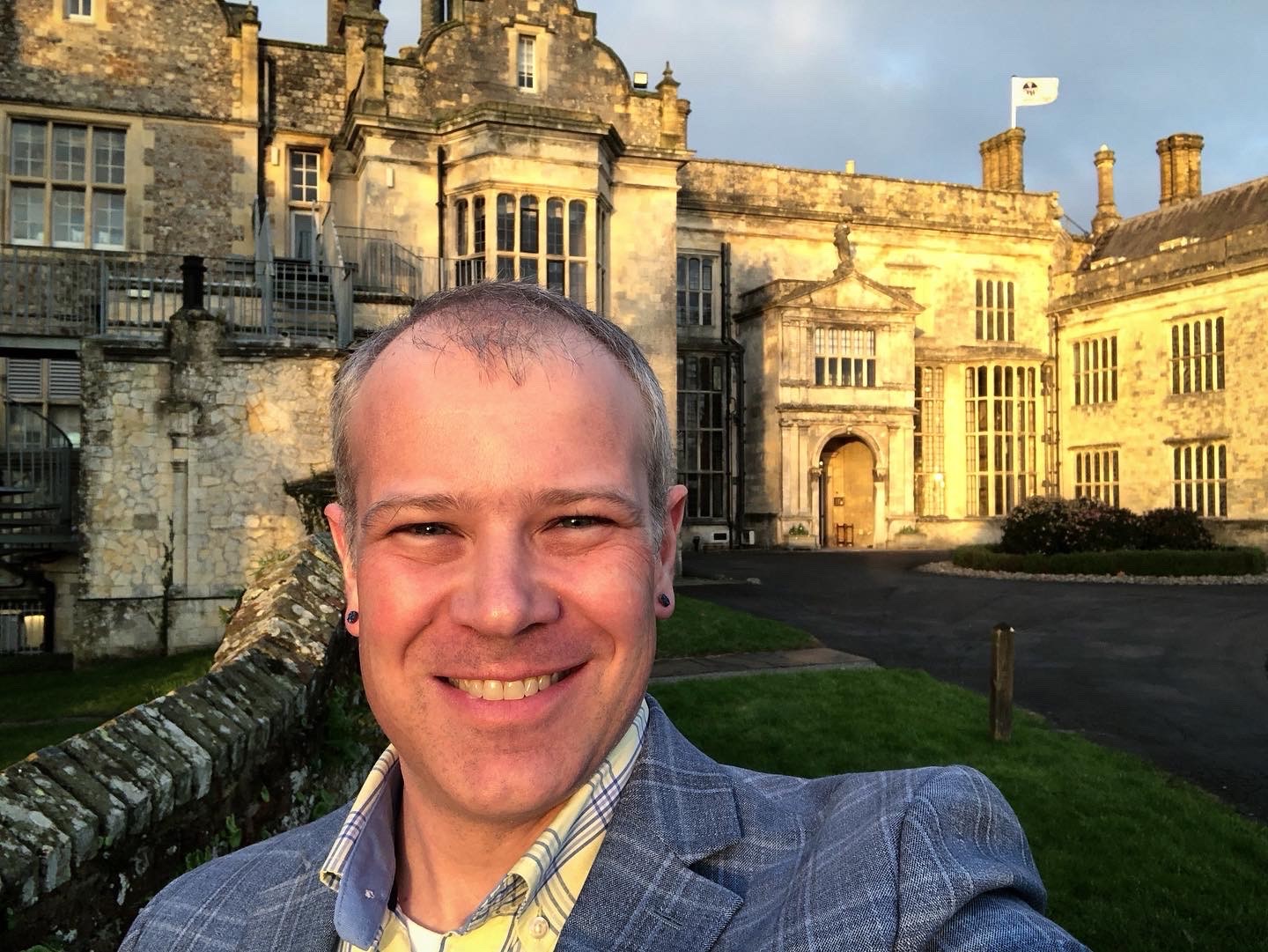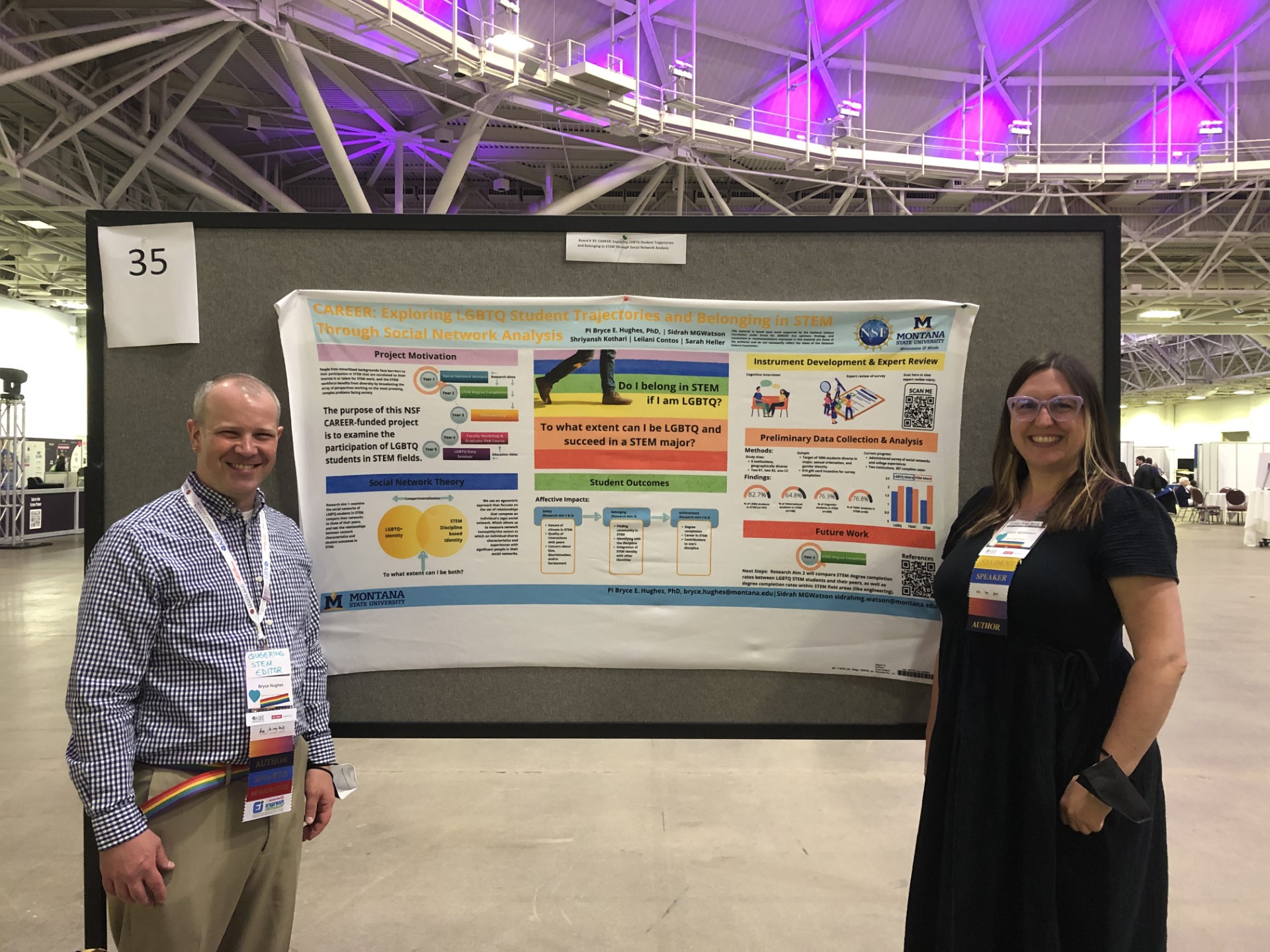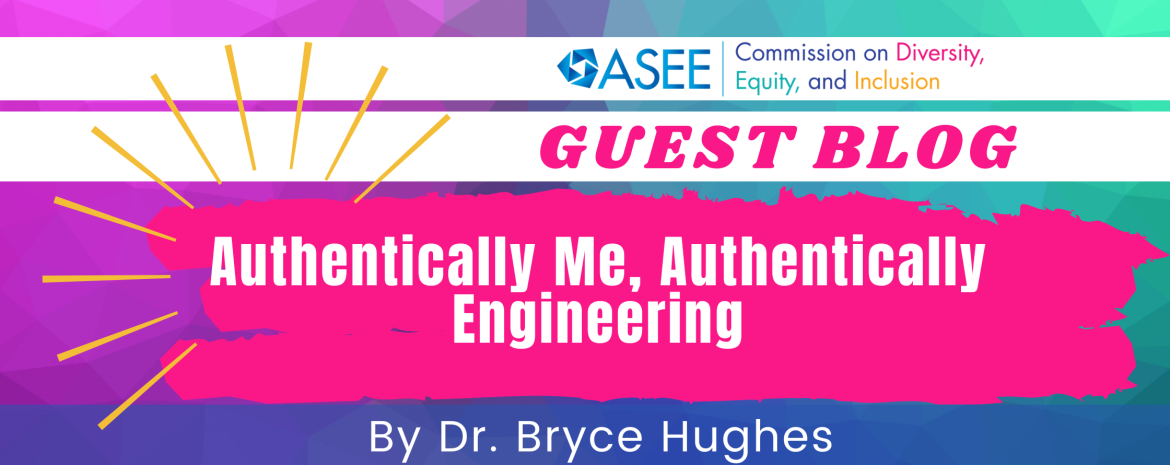Authentically Me, Authentically Engineering
By Bryce E. Hughes, Ph.D.
Like many of our students, I grappled with several complex academic challenges while navigating my pathway through an undergraduate engineering program. On top of these challenges, I was also grappling with the intricacies of coming out as gay in an environment not always embracing of diverse identities—a Catholic university. While serving as one of the few visible leaders in our campus LGBTQ student organization, I was also inadvertently building walls as a barrier between myself and my engineering peers. It wasn’t until much later, while I was immersed in the world of STEM education research, that I pondered how this dynamic may have influenced my career choices. Ultimately, I decided not to continue my journey as a practicing engineer, opting rather to take on a role at my undergraduate institution establishing an LGBTQ resource office that will be celebrating its twentieth anniversary this year.
 In 2018, I published a paper that allowed me to explore whether we would observe similar patterns of departure from STEM majors among LGBTQ students as we have with students from other minoritized groups in STEM. The reception of this paper in the field encouraged me to pursue this topic even further, including one pivotal moment which arose when an email from a former math major echoed my experiences. They, too, felt isolated in STEM, finding comfort primarily outside their major—a sentiment mirroring my own. This poignant exchange prompted a deeper examination of how social context shapes the academic and professional trajectories of LGBTQ students in STEM, which became the first of three research aims structuring my eventual NSF CAREER award to examine the participation of LGBTQ undergraduate students in STEM fields.
In 2018, I published a paper that allowed me to explore whether we would observe similar patterns of departure from STEM majors among LGBTQ students as we have with students from other minoritized groups in STEM. The reception of this paper in the field encouraged me to pursue this topic even further, including one pivotal moment which arose when an email from a former math major echoed my experiences. They, too, felt isolated in STEM, finding comfort primarily outside their major—a sentiment mirroring my own. This poignant exchange prompted a deeper examination of how social context shapes the academic and professional trajectories of LGBTQ students in STEM, which became the first of three research aims structuring my eventual NSF CAREER award to examine the participation of LGBTQ undergraduate students in STEM fields.
Last summer, at the ASEE 2023 conference, my former research assistant and I presented a paper from some of the early analysis we have been able to perform on the data collected as part of the first research aim of the project. That paper earned the Best Diversity Paper award for the Educational Research and Methods division of ASEE, and was then recognized by the Committee on Diversity, Equity, and Inclusion as a finalist for overall Best Diversity Paper at ASEE 2023, which prompted the invitation for this post about our research. In that paper, we delved into the likelihood that LGBTQ students in STEM had disclosed their identities with peers in their STEM majors. What intrigued us was examining this likelihood of being “out” as an indicator of the climate in STEM which would not typically be gathered on diversity surveys—yet this decision to be open about being LGBTQ should reflect a more welcoming environment for LGBTQ individuals.
The literature on the experiences of LGBTQ students in engineering and other STEM fields reflects how the culture in STEM often pressures individuals to separate their personal and technical experiences, which tends to disproportionately affect minoritized communities. LGBTQ individuals, feeling compelled to compartmentalize their identities, either conceal or downplay their LGBTQ selves in engineering and science. We wondered whether this compartmentalization could be observed through observation and analysis of the structure of STEM students’ social networks. We surveyed over 200 LGBTQ college students across three US universities nationally to assess the composition of their academic and personal support networks. One question we asked was whether a given network member knew that the participant identified as LGBTQ, and while we discovered that, yes, LGBTQ students were less likely to be out to STEM peers, approximately 60% were open about their identities within STEM circles. Even though the data demonstrated the disparity we hypothesized, LGBTQ students are likely to be out to more than a majority of their peers in STEM. Further, this difference was not as prominent in our regression models, possibly reflective of some statistical limitations, but continued to provide evidence that perhaps the climate is improving even if not ideal now.
Although our findings are encouraging on the surface, there are additional questions raised by these findings which we are unable to answer with our analyses alone. First, despite LGBTQ STEM students being open about their identities with their STEM peers, a complex interplay of factors influences the context and extent of this disclosure. This intricate dance between personal identity and professional pursuits unveils the need for a holistic understanding of LGBTQ experiences in STEM, which undergirds the third research aim of our study exploring how LGBTQ students experience engineering and science identity.
Second, compartmentalization of LGBTQ identity in STEM contexts manifests in varied and nuanced ways which cannot be entirely measured through a binary variable asking whether one is out or not to various network members. LGBTQ individuals, striving to navigate social stigma and STEM career aspirations, continue to grapple with the decision to disclose their identities within the STEM community. Identity management is more than just disclosure or nondisclosure; identity management also involves how an individual expressed their identity within different settings. Engineering and other STEM students may be out about being LGBTQ within academic settings, yet they might also downplay, or cover, their LGBTQ identities to reduce the prominence of these identities within those settings. Identity management in this sense may take less energy than passing as heterosexual or cisgender, but it may still undermine their belonging in STEM and sustained commitment to STEM majors nonetheless.

Bryce Hughes and Sidrah Watson presenting a poster at ASEE 2022 in Minneapolis.
Implications for Engineering Educators
As I mentioned, we found our results incredibly encouraging as they suggested the climate in STEM was improving for LGBTQ students. However, these trends require the continued participation of engineering educators to help keep the momentum moving in the direction of greater inclusion. As such, we identified several implications for engineering educators from our research.
1. Fostering Inclusivity in the Classroom:
Instructors’ primary sphere of influence is the engineering classroom. How are you establishing your courses as a place where LGBTQ students do not need to actively hide their LGBTQ identities? Demonstrate your commitment to inclusivity by acknowledging and incorporating diverse perspectives within your class materials. Integrate examples and voices that reflect the spectrum of identities, fostering open dialogues where every student feels acknowledged. Make your commitment to an equitable learning environment explicit within your syllabus and on the first day. Use the names and pronouns that your students use as a show of respect and validity for who they are.
2. Addressing Systemic Barriers:
Zooming out from the confines of the classroom, consider how the broader departmental, college, and institutional landscape affects the student experience. Systemic barriers within colleges of engineering demand scrutiny, prompting educators to assess recruitment practices, mentorship opportunities, and anti-discrimination policies. Implicit biases, potentially shaping departmental climates, underscore the urgency of fostering inclusive spaces. There are LGBTQ students within your academic units, so if you feel like you are not seeing any, chances are your LGBTQ students are facing some of these barriers.
3. Building Inclusive Spaces:
Sense of belonging has emerged as a paramount outcome in our research as it serves as an intermediate outcome that motivates students to follow through on their professional pursuits. Inclusive practices extend beyond the classroom, encompassing the creation of a culture where every student, regardless of identity, sees themselves as a part of the academic enterprise. Initiatives like oSTEM not only provide social support but also bridge the gap between personal and professional development, fostering a community where students can authentically be themselves within engineering and other STEM fields. And many LGBTQ students are also part of other social identity groups that are underserved by and underrepresented in engineering: embrace an intersectional lens that acknowledges that the multiple aspects of identity are not experienced in isolation, and tailor inclusive practices accordingly.
4. Promoting Allyship:
Finally, your role as a potential ally to LGBTQ students, as well as your LGBTQ colleagues, is a cornerstone of your commitment to inclusion. The meaning of “ally” may have evolved, especially away from it being an endstate to reach, but the essence of self-awareness and commitment remains. Engage in self-work to understand your perspectives and biases. Actively seek out opportunities for learning, challenge colleagues to commit to allyship, and participate in initiatives like ASEE’s Safe Zone training offered throughout the year in a virtual format and at every national conference in person. The effect of your allyship work will ripple out from your individual office and classroom, permeating the broader engineering community.
Conclusion
Our research has helped paint a landscape that shows strides have been made toward LGBTQ inclusion within engineering and STEM fields, yet challenges remain. Dismantling preconceived notions surrounding the separation of personal and technical realms is imperative. Policymakers, industry leaders, and educators all share the responsibility of creating a future where authenticity thrives within engineering.
The onus for engineering educators lies not only in acknowledging diversity but in actively reshaping the cultural narrative in STEM. It involves creating spaces where LGBTQ individuals, and indeed all minoritized groups, do not face a dichotomy between their professional aspirations and personal happiness. Rather, engineering educators are called to help cultivate an engineering environment where authenticity is not just celebrated—it becomes held as integral to the very essence of being an engineer. Let us contribute to a future where the authentic engineer is authentically themselves.
About the Author

MSU photo by Kelly Gorham
Bryce Hughes (he, him, his)
Bryce E. Hughes is an associate professor of education at Montana State University and has been a member of ASEE since 2018. He holds a PhD in education from UCLA, an MA in student development administration from Seattle University, and a BS in general engineering from Gonzaga University. His research is primarily focused on LGBTQ+ inclusion in engineering and other STEM fields, with support from an NSF CAREER award and a grant from the Royal Society for Chemistry in the UK. Dr. Hughes’s work was recently recognized at the 2023 ASEE National Conference through Best Diversity Paper awards from the ERM and LEES divisions, one of which was recognized as a finalist for CDEI’s overall Best Diversity, Equity, and Inclusion Paper Award. He was also a recent recipient of the Montana State President’s Award for Gender Equity. He lives outside of Bozeman, MT, with his husband, and he enjoys music, reading, and playing video games.
Do you want to become a guest blogger?
CDEI Guest Blog highlight future events, describe best practices, or share calls to action by CDEI members. We invite you to propose posts that share brief research highlights, reports of impactful initiatives, critical thought pieces, and resources you find useful. We especially encourage emerging scholars to share their work. If you are interested in sharing a blog or resource post, you may submit your proposal here. All posts are screened and edited.

